Exercise 15.1
(1) The following graph shows the temperature of a patient in a hospital, recorded every hour.
(a) What was the patient’s temperature at 1 p.m?
(b) When was the patient’s temperature 38.5 oc?
(c) The patient’s temperature was the same two times during the period given. What was these two times?
(d) What was the temperature at 1.30 p.m.? How did you arrive at your answer?
(e) During which periods did the patient’s temperature showed an upward trend?

Ans-
(a) The patient’s temperature at 1 p.m. was 36.50c.
[At 1 p.m. temperature is showing exact between 360c and 370c.]

(b) At 12 noon the patient’s temperature was 38.5 oc.
(c) At 1 p.m. and 2 p.m. patient’s temperature was the same.
(d) At 1.30 p. m. temperature was 36.50c. First we locate 1.30 p. m. on x axis and then move up from there to know the temperature. We meet the point which lies at 36.50c on y axis.
(e) The patient’s temperature showed an upward trend in following time periods-
(i) 9 a.m. to 10 a.m.
(ii)10 a.m. to 11 a. m
(iii)2p.m. to 3 p.m.
(2) The following line graph shows the yearly sales figures for a manufacturing company.
(a) What were the sales in (i) 2002 (ii) 2006?
(b) What were the sales in (i) 2003 (ii) 2005?
(c) Compute the difference between the sales in 2002 and 2006.
(d) In which year was there the greatest difference between the sales as compared to its previous year?
Ans-
(a) The sales in
(i) 2002 were Rs 4 crores.
(ii) 2006 were Rs 8 crores.
(b) The sales in
(i) 2003 were Rs 7 crores.
(ii) 2005 were Rs 10 crores.

(c) Difference between the sales in 2002 and 2006 is that sales increase in 2006 by Rs 4 crores (Sales of 2006 – sales of 2002).
(d) Sales in 2002 = Rs 4 crores
Sales in 2003 = Rs 7 crores
Sales in 2004 = Rs 6 crores
Sales in 2005 = Rs 10 crores
Sales in 2006 = Rs 8 crores
Difference between the sales in 2003 and 2002 =Rs (7 – 4)crores
= Rs 3 crores
Difference between the sales in 2004 and 2003 =Rs (6 – 7)crores
= Rs -1 crores
Difference between the sales in 2005 and 2004 =Rs (10 – 6)crores
= Rs 4 crores
Difference between the sales in 2006 and 2005 =Rs (8 – 10)crores
= Rs -2 crores
Hence, the greatest difference between the sales as compared to its previous year was in 2005.
(3) For an experiment in Botany, two different plants, plant A and plant B were grown under similar laboratory conditions. Their heights were measured at the end of each week for 3 weeks. The results are shown by the following graph.
(a) How high was Plant A after (i) 2 weeks (ii) 3 weeks?
(b) How high was Plant B after (i) 2 weeks (ii) 3 weeks?
(c) How much did Plant A grow during 3rd week?
(d) How much did Plant B grow from end of the 2nd week to the end of the 3rd week?
(e) During which week did Plant A grow most?
(f) During which week did Plant B grow least?
(g) Were the two plants of the same height during any week shown here? Specify.
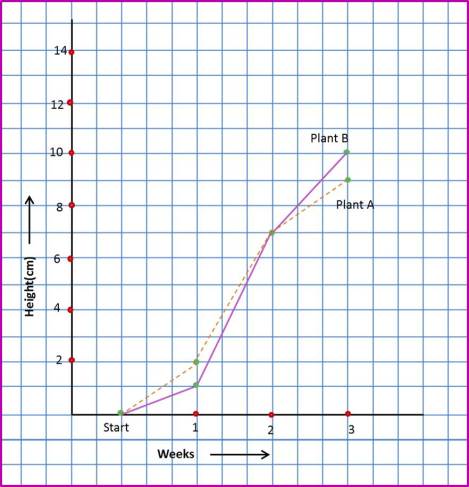
Ans-
(a)The Plant A height was after
(i) 2 weeks was 7 cm.
(ii) 3 weeks was 9 cm.
(b) The Plant B height was after
(i) 2 weeks was 7 cm.
(ii) 3 weeks was 10 cm.
(c) Height of the Plant A during 2 weeks = 7 cm
Height of the Plant A during 3 weeks = 9 cm
Growth of the plant A = Height of the Plant A during [3 week – 2 week]
= 9 – 7 cm
= 2 cm
Hence, Plant A grows 2 cm.
(d) Height of the Plant B during 2 weeks = 7 cm
Height of the Plant B during 3 weeks = 10 cm
Growth of the plant B = Height of the Plant B during [3 week – 2 week]
= 10 – 7 cm
= 3 cm
Hence, Plant B grows 3 cm.
(e) Height of the Plant A during 1 weeks = 2 cm
Height of the Plant A during 2 weeks = 7 cm
Height of the Plant A during 3 weeks = 9 cm
Growth of Plant A in 1st week = Height of the Plant A during [1 week – start]
= 2 – 0
=2 cm
Growth of Plant A in 2nd week = Height of the Plant A during [2 week – 1 week]
= 7 – 2
=5 cm
Growth of Plant A in 3rd week = Height of the Plant A during [3 week – 2 week]
= 9 – 7
=2 cm
Hence, Plant A grows in 2nd week the most.
(f) Height of the Plant B during 1 weeks = 1 cm
Height of the Plant B during 2 weeks = 7 cm
Height of the Plant B during 3 weeks = 10 cm
Growth of Plant B in 1st week = Height of the Plant B during [1 week – start]
= 1 – 0
=1 cm
Growth of Plant B in 2nd week = Height of the Plant B during [2 week – 1 week]
= 7 – 1
=8 cm
Growth of Plant B in 3rd week = Height of the Plant B during [3 week – 2 week]
= 10 – 7
=3 cm
Hence, Plant B grows in 1st week the least.
(g) The two plants shows same height in week 2,ie, 7cm because line graphs of their growth meets at 2nd weeks.
(4) The following graph shows the temperature forecast and the actual temperature for each day of a week.
(a) On which days was the forecast temperature the same as the actual temperature?
(b) What was the maximum forecast temperature during the week?
(c) What was the minimum actual temperature during the week?
(d) On which day did the actual temperature differ the most from the forecast temperature?

Ans-
(a) The forecast temperature and the actual temperature were same on Tuesday, Friday and Sunday.
(b) The maximum forecast temperature during the week was 350c.
(c) The minimum actual temperature during the week was 150c.
(d) Actual temperature on Monday = 17.50c
Forecast temperature on Monday = 150c
Difference of actual temperature from the forecast temperature on Monday
= Actual temperature on Monday – Forecast temperature on Monday
= 17.5 – 15
= 2.50c
Actual temperature on Tuesday = 200c
Forecast temperature on Tuesday = 200c
Difference of actual temperature from the forecast temperature on Tuesday
= Actual temperature on Tuesday – Forecast temperature on Tuesday
= 20 – 20
= 00c
Actual temperature on Wednesday = 300c
Forecast temperature on Wednesday = 250c
Difference of actual temperature from the forecast temperature on Wednesday
= Actual temperature on Wednesday- Forecast temperature on Wednesday
= 30 – 25
= 50c
Actual temperature on Thursday = 150c
Forecast temperature on Thursday = 22.50c
Difference of actual temperature from the forecast temperature on Wednesday
= Actual temperature on Wednesday- Forecast temperature on Wednesday
= 15 – 22.5
= – 7.50c
Actual temperature on Friday = 150c
Forecast temperature on Friday = 150c
Difference of actual temperature from the forecast temperature on Friday
= Actual temperature on Friday – Forecast temperature on Friday
= 15 – 15
= 00c
Actual temperature on Saturday = 250c
Forecast temperature on Saturday = 300c
Difference of actual temperature from the forecast temperature on Saturday
= Actual temperature on Saturday – Forecast temperature on Saturday
= 25 – 30
= – 50c
Actual temperature on Sunday = 350c
Forecast temperature on Sunday = 350c
Difference of actual temperature from the forecast temperature on Sunday
= Actual temperature on Sunday – Forecast temperature on Sunday
= 35 – 35
= 00c
Hence, actual temperature and forecast temperature differ the most on Thursday.
(5) Use the tables below to draw linear graphs.
(a) The number of days a hill side city received snow in different years.
| Year | 2003 | 2004 | 2005 | 2006 |
| Days | 8 | 10 | 5 | 12 |
(b) Population (in thousands) of men and women in a village in different years.
| Year | 2003 | 2004 | 2005 | 2006 | 2007 |
| Number of men | 12 | 12.5 | 13 | 13.2 | 13.5 |
| Number of women | 11.3 | 11.9 | 13 | 13.6 | 12.8 |
Ans-
(a) The required linear graph is showing below:-
(b) The required linear graph is showing below:-
6) A courier – person cycles from a town to neighbouring suburban area to deliver a parcel to a merchant. His distance from the town at different times is shown by the following graph.
(a) What is the scale taken for the time axis?
(b) How much time did the person take for the travel?
(c) How far is the place of the merchant from the town?
(d) Did the person stop on his way? Explain?
(e) During which period did he ride fastest?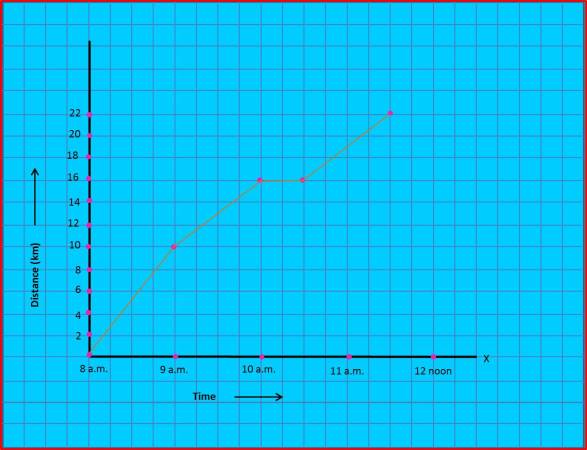

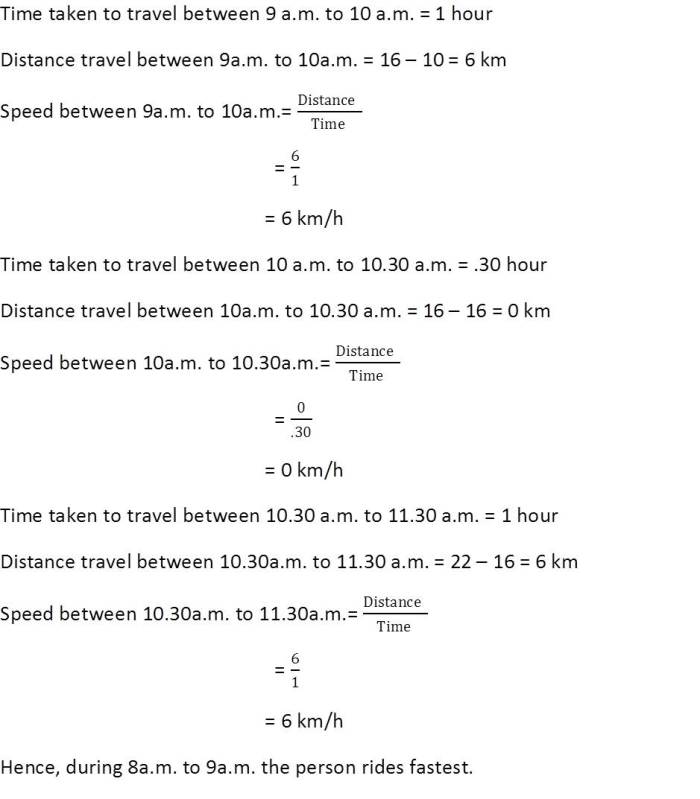 (7) Can there be a time – temperature graph as follows? Justify your answer.
(7) Can there be a time – temperature graph as follows? Justify your answer.
![]()

![]()
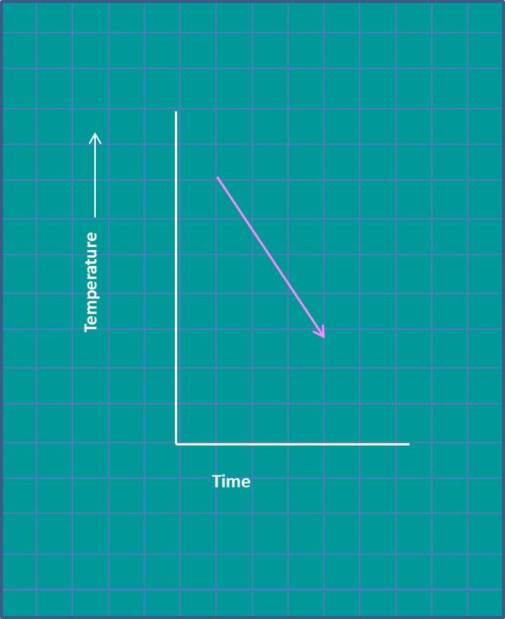
![]()
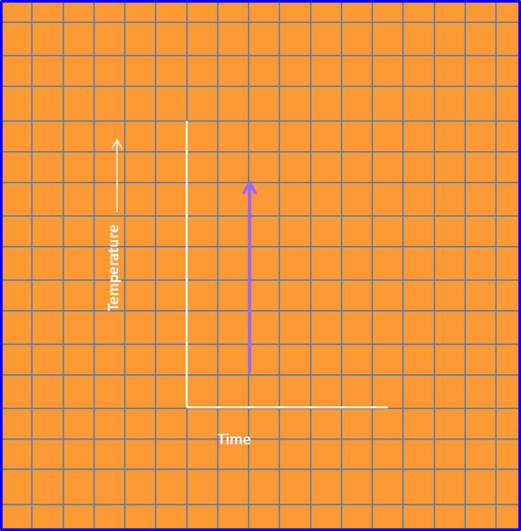
![]()

Ans-
Graph (iii) can not be a time – temperature graph because in line graph data changes continuously over period of time but in given graph time is constant and only temperature changes.
Exercise 15.2
(1) Plot the following points on a graph sheet. Verify if they lie on a line
(a) A(4,0), B(4,2), C(4, 6), D(4, 2.5)
(b) P(1, 1), Q(2, 2), R(3, 3), S(4, 4)
(c) K(2, 3), L(5, 3), M(5, 5), N(2, 5)
Ans-
(a) All points lie on a line.

(b) All points lie on a line.
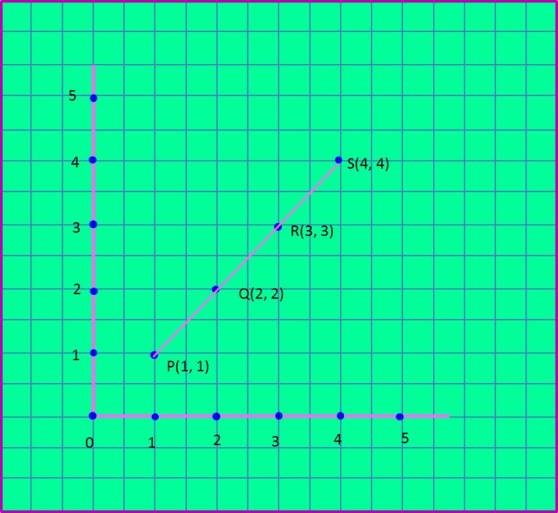
(c) All points do not lie on a line.

(2) Draw the line passing through (2, 3) and (3, 2). Find the coordinates of the points at which this line meets the x – axis and y -axis.
Ans-
Coordinates of point A placed on x axis are (5, 0)
Coordinates of point B placed on Y axis are (0, 5)
(3) Write the coordinates of the vertices of each of these adjoining figures.

Ans-

The vertices of the O are (O, 0).
The vertices of the A are (2, 0).
The vertices of the B are (2, 3).
The vertices of the C are (0, 3).
The vertices of the P are (4, 3).
The vertices of the Q are (6, 1).
The vertices of the R are (6, 5).
The vertices of the S are (4, 7).
The vertices of the L are (7, 7).
The vertices of the K are (10, 5).
The vertices of the M are (10, 8).
(4) State whether True or False. Correct that are false.
(i) A point whose x coordinate is zero and y – coordinate is non – zero will lie on the y – axis.
(ii) A point whose y coordinate is zero and x coordinate is 5 will lie on y – axis.
(iii) The coordinates of the origin are(0, 0).
Ans-
(i) A point whose x coordinate is zero and y – coordinate is non – zero will lie on the y – axis. True
(ii) A point whose y coordinate is zero and x coordinate is 5 will lie on y – axis. False
Correct statement: A point whose y coordinate is zero and x coordinate is 5 will lie on x – axis.
(iii) The coordinates of the origin are(0, 0). True
Exercise 15.3
(1) Draw the graphs for the following tables of values, with suitable scales on the axes.
(a) Cost of apples
| Number of apples | 1 | 2 | 3 | 4 | 5 |
| Cost (Rs) | 5 | 10 | 15 | 20 | 25 |
(b) Distance travelled by a car
| Time (hour) | 6a.m. | 7 a.m. | 8 a.m. | 9 a.m. |
| Distance(Km) | 40 | 80 | 120 | 160 |
(i) How much distance did the car cover during the period7.30 a.m. to 8 a.m.?
(ii) What was the time when the car had covered a distance of 100 km since it’s start?
(c) Interest on deposits for a year.
| Deposit(Rs) | 1000 | 2000 | 3000 | 4000 | 5000 |
| Simple interest(Rs) | 80 | 160 | 240 | 320 | 400 |
(i) Does the graph pass through the origin?
(ii) Use the graph to find the interest on Rs 2500 for a year?
(iii) To get an interest of Rs 280 per year, how much money should be deposited?
Ans-
(a) The graph for given data is represented below:-

(b) The graph for given data is represented below:-
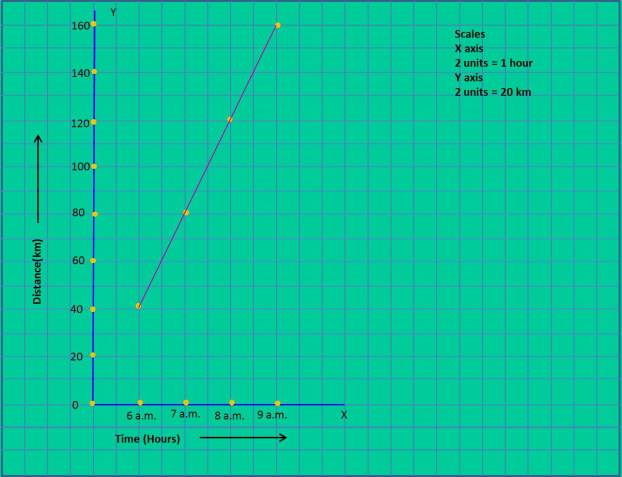
(i) Position of car at 7.30 a.m. = 100km
Position of car at 8 a.m. = 120 km
Distance travelled during the period7.30 a.m. to 8 a.m.= (120 – 100)km
(ii) The time when the car had covered a distance of 100 km since it’s start was 7.30 a.m.
(c)

(i) Yes, graph passes through origin.
(ii) Rs 200 will be find as interest on Rs 2500 for a year.
(iii) Rs 3500 should be deposited to get an interest of Rs 280 per year.
(2) Draw a graph for the following.
(i)
| Side of square (cm) | 2 | 3 | 3.5 | 5 | 6 |
| Perimeter(cm) | 8
|
12
|
14
|
20
|
24 |
Is it a linear graph?
(ii)
| Side of square (cm) | 2 | 3 | 3.5 | 5 | 6 |
| Area (cm2) | 4
|
9
|
16
|
25
|
36
|
Is it a linear graph?
Ans-
(i)
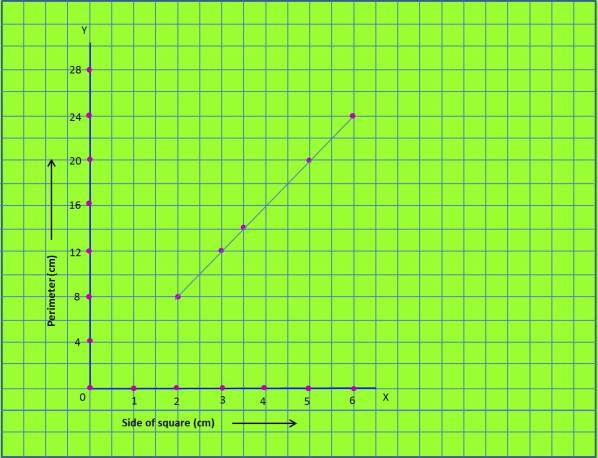
It is a linear graph.
(ii)

It is not a linear graph.
Helping Topics
